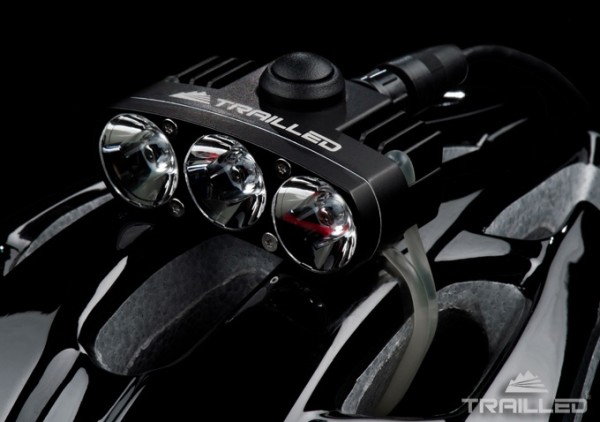I’ve said it before and I’ll say it again; I love night rides! Apparently Trail LED’s founder Grady Pace also enjoys night riding, so much that he set out to create some top-tier helmet specific lights after finding disappointment from other brand’s offerings. While most companies stick to a more universal design that will work on both a handlebar and helmet, these multi-mount lights tend to be heavy and sit up high. They can cause neck fatigue and encourage helmet movement, or even worse can get snagged on low branches.
So starting seven years ago, Pace set out to create the lightest and brightest possible helmet specific lights and developed Trail LED’s unique low profile arced shape that rises just ¾” from the top of your helmet. Shine a light past the break for all the details on three different models that output between 1800 and 6000 lumens and how they’re looking to expand…
Trail LED is based out of Dallas, TX, and operates with the conviction that rider safety depends on the quality of their American-made products. The lights are fully developed and have been in action for some time (we reviewed them here) so their Kickstarter campaign was launched to fund for manufacturing costs as the company is looking to expand greatly and venture into the ATV and Motocross markets.
All of Trail LED’s headlights feature CNC machined anodized aluminum bodies. The curved design creates what they call Multi-Point Shadow Definition (MPSD), with the bulb positioning filling in dark spots on the trail ahead. Pace suggests this renders a secondary handlebar light unnecessary.
The lights all operate via a large, tactile single button for easy use in the dark or with gloves on, and they mount with simple o-rings. The flexible o-rings can be attached between any of the light’s cooling fins for a nice tight fit on any helmet. If you’re wondering about your helmet fitting the arc on the Halo light, they have tried over 100 different lids so far with no issues.
Trail LED’s battery pack is a fairly compact cube with a rubberized coating to help it stay put in jersey pockets. If you happen to enjoy 24 hour races, the charger operates at a 1:1 ratio so you only need two battery packs to run the lights continuously. The power cable secures to the light with a quarter-twist lock to prevent potential mid-ride disconnections.
All three models come with one battery pack, a charger, two helmet mount o-rings, a Trail LED handlebar mount (which sits centrally over your stem) plus Garmin and GoPro mount adapters. Despite the different outputs, they all take two hours to charge.
The XXX is the smallest model, outputting 1800 lumens with its three Cree LEDs. The body weighs just 50g, and its burn times are three hours on high, six hours on low and 27 hours in emergency mode. Early birds can snag one for $300 USD, but the price will go up to $350.
The DS pumps out 3000 lumens via five LEDs. The body weighs 100g and it runs for two hours on high, four hours on low and 18 hours in emergency mode. The current Kickstarter price is $500, which will go up to $550.
The Halo cranks out an amazing 6000 lumens with 10 LED’s that span almost ear-to-ear. The body still weighs only 200g, and the Halo lasts two hours on high, four hours on low and 38 hours in emergency mode. Kickstarter buyers can have it for $1000, before the price rises to $1100.
Trail LED has undergone independent testing and promises their lights produce as many lumens as advertised, unlike cheap imported units that often don’t. Their lights are guaranteed for life against manufacturing defects, and the batteries are warrantied for 90 days. User caused damage can also be repaired by Trail LED, at the cost of parts and labor. On top of that updates and upgrades will be available in the future, keeping your high-end light from becoming outdated.
If you live in the Dallas/Fort Worth area, for a $100 donation you can meet the company founder and go for a test ride with all three models. Otherwise, check out their Kickstarter campaign or website for more info.






